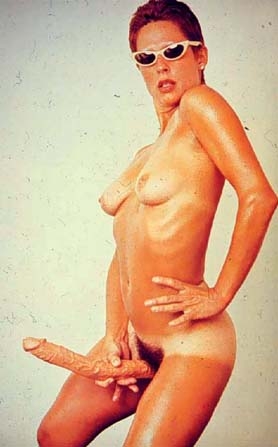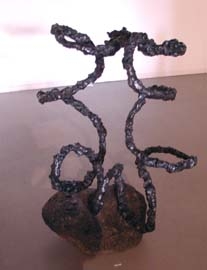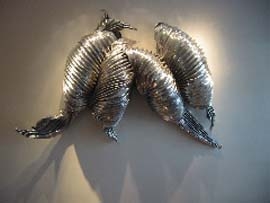Feature: Reviews
Lynda Benglis
- Toomey-Tourell Gallery
- 49 Geary Street, San Francisco
- November 15 - January 3, 2004
Several decades ago, Lynda Benglis achieved fame and notoriety by placing a full-color ad in ArtForum that consisted of a photograph of herself nude except for a large strap-on dildo. It was her way of protesting the macho male monopoly of the art scene of the times. In this overview of Ms. Benglis’s work in the 1990s, the masculine-feminine, yin-yang tension is alive and well; power continues to inform her work, as does the interplay of texture, form, material, gesture, and mass.
The first piece you see on entering is Double Trouble (1991), a bronze and stone sculpture. Two entangled forms, resembling snakes, loop several feet into the air. The fact that they are made of bronze contrasts with both the delicate linear and gestural nature of the forms themselves, and with the texture of work, which is covered with thumb and finger prints. You can’t get away from the human, transient quality of the piece; yet there is no escaping it is bronze, and will be around long after the maker of the thumbprints is dust.
To further emphasize this contrast in themes, the base of Double Trouble is a smooth, elliptical volcanic rock which looks like a meteorite going back billions of years. The power and permanence of the base emphasizes those qualities in the bronze, while contrasting with the humanized texture and gesture of line.
Benglis’s interest in materiality, power, and the play between the organic, the ephemeral, and the (relatively) permanent can be seen in much of her work at Toomey Tourell. Totem II (1991) is a tall tower of finger-pinched bronze atop a block of red sandstone. At once organic in form and texture, there is an ageless and quiet power in the relationship of the material to the totemic symbolism. Sticks and Stones (1991) is an almost humorous play on materiality and symbolism, combining a gravity-defying linear swoop of fingered bronze with bronze casts of actual branches. Oddly, the branches maintain an impermanent quality, while the piece as a whole is enduring.
Scarab (1990), perhaps the most significant piece in the exhibit, takes a different approach to interplay of materiality, form, and permanence. Constructed of steel mesh and aluminum, the large wall piece has a pleated surface that gives the illusion of a piece of cloth dipped in metal. The form, however, is highly organic - it might be a mollusk, a beetle, or even a giant piece of shiny candy. Benglis’s significant achievement is to balance these contrasting elements - metal, cloth, and organic form - in a way that is delightful and probing, rather than bizarre and cumbersome.
In addition to sculpture, the exhibit includes a number of framed works of pigmented wax on paper. These are more purely abstract explorations of color and texture. The wax creates a refractive quality that generates unusual milky colors of considerable beauty, but I did not respond as strongly to the wax-on-paper work as I did to the sculpture.
Through all her works, Benglis maintains a strong interest in surface, and the play between direct and symbolic representation. Her choice of metal and stone as a medium for her organic and linear forms is instructive; other choices would not convey so forcefully her interest in power, mass, and the balance of feminine and masculine.



